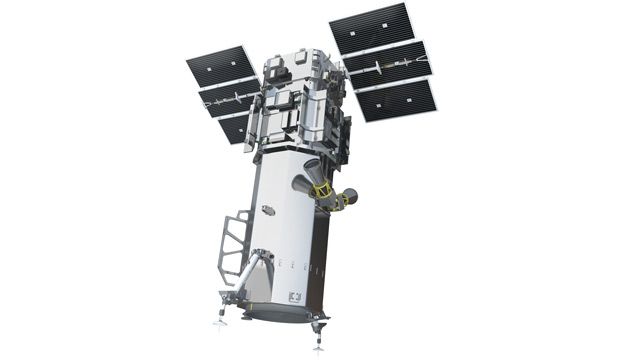DigitalGlobe Simulates Complete Satellite-to-Ground Communications Systems
“We needed to know if our communications system would support a 50% increase in data rate. By modeling and simulating the antenna, transmitter, and receiver designs in Simulink, we got a direct answer: Yes. We had confidence in this answer because the simulations showed us how the system performed.”
Challenge
Solution
Results
- Simulation speed increased tenfold
- Distortion effects included in simulation
- Data rate increased by 50%

The WorldView-3 satellite from DigitalGlobe, now Maxar Technologies, is the industry’s first multipayload, superspectral, high-resolution commercial satellite. WorldView-3 is capable of imaging up to 680,000 square kilometers per day with a 31 cm panchromatic resolution.
To deliver all this imagery data back to Earth, DigitalGlobe satellites require communications systems that are both fast and reliable. DigitalGlobe engineers model and simulate these systems in Simulink® to gauge bit-error rates (BER) and identify opportunities for improving performance.
“If we have an uncorrectable bit error in our image data, we have to resend the image file, which is costly,” says Skip Cubbedge, aerospace engineer at DigitalGlobe. “Our Simulink simulations enable us to see exactly how hard we can push our systems to maintain both a maximum data rate and an essentially perfect link.”
Challenge
DigitalGlobe communications systems operate in the X-Band between 8.025 and 8.040 GHz, which is adjacent to the frequency band used by the Deep Space Network (DSN). To avoid interfering with DSN signals, DigitalGlobe engineers had to meet stringent out-of-band emissions and power requirements, even as they sought to increase their downlink data rate from 800 Mbps to 1200 Mbps for WorldView-3.
The team needed to implement filters with steep edges, but such filters can distort the signal. Further, as they moved from QPSK to an 8-PSK modulation scheme, they needed to accurately model cross-polarization interference to ensure there was enough link margin for the system to operate reliably.
In the past, DigitalGlobe engineers working on similar projects used an off-the-shelf software package for communications systems modeling. With this package, BER simulations could take weeks, and licensing costs were high. DigitalGlobe sought a less expensive alternative that would be faster and easier to use.
Solution
DigitalGlobe engineers modeled the complete communications system for their newest satellite in Simulink and performed extensive simulations to ensure reliable performance at 1200 Mbps data rates.
The end-to-end Simulink model included an amplifier, an 8-PSK modulator and demodulator, an encoder and decoder, filters, equalizers, and the space-to-ground channel, modeled as additive white Gaussian noise.
The encoding and decoding components were modeled using Reed-Solomon encoding and decoding blocks from Communications Toolbox™.
The engineers used Communications Toolbox to model the receiver’s adaptive equalizers using an LMS algorithm running in decision-directed mode.
They used the Filter Design and Analysis app in Signal Processing Toolbox™ to design and calibrate the system’s Butterworth filter. They modeled the amplifier and other RF components using RF Blockset™ and RF Toolbox™. They used the models to evaluate how RF effects affected baseband data rates. The models also enable them to trade off filter bandwidths with equalizer complexity.
To verify that the system had a bit-error rate of less than 10-6, they ran simulations in Simulink in which 10 million bits were transmitted. Additional simulations were used to analyze effects due to distortion, the environment, and the satellite’s elevation.
Using DSP System Toolbox™ and Communications Toolbox, the team conducted spectral analysis, and produced eye diagrams, vector scatter plots, and constellation plots to visualize simulation results and analyze system behavior.
DigitalGlobe has completed development of the communications system for WorldView-3, achieving the target data rate of 1200 Mbps. The team is currently using Simulink to model and simulate the WorldView-4 communications system.
Results
Simulation speed increased tenfold. “For simulations, Simulink is 10 times faster than the communications systems modeling package we used previously,” says Cubbedge. “Plus, Simulink models are much easier to instrument, so we can quickly see carrier phase offset, bit synchronization, or any other detail as the simulation runs.”
Distortion effects included in simulation. “Simulations with our previous software took so long—days for a single data point—that I could never gauge the effects of distortion,” says Cubbedge. “With Simulink, for the first time I can see past the noise effect and understand how distortion is affecting the link.”
Data rate increased by 50%. “Using the same antenna hardware we had used for data rates of 800 Mbps on earlier satellites, we built a communications system capable of 1200 Mbps,” Cubbedge says. “We have confidence in the system because of our simulations in Simulink. Without those simulations it would be impossible for me to show management that the system is going to work.”